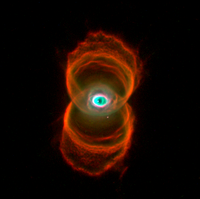Hourglass Nebula
| Nebula | |
|---|---|

Hubble Space Telescope image of the Hourglass Nebula
|
|
| Observation data: J2000 epoch | |
| Right ascension | 13h 39m 35.116s |
| Declination | −67° 22′ 51.45″ |
| Distance | 8 kly (2.5 kpc) ly |
| Apparent magnitude (V) | 13.0 |
| Constellation | Musca |
| Physical characteristics | |
| Radius | - ly |
| Absolute magnitude (V) | - |
| Notable features | - |
| Designations |
ESO 97-1, |
ESO 97-1,
Engraved Hourglass Nebula,
Etched Hourglass Nebula,
The Engraved Hourglass Nebula (also known as MyCn 18) is a young planetary nebula in the southern constellation Musca about 8,000 light-years from Earth. It was discovered by Annie Jump Cannon and Margaret W. Mayall during their work on an extended Henry Draper Catalogue (the catalogue was built between 1918 and 1924). At the time, it was designated simply as a small faint planetary nebula. Much improved telescopes and imaging techniques allowed the hourglass shape of the nebula to be discovered by Raghvendra Sahai and John Trauger of the Jet Propulsion Laboratory on January 18, 1996. It is conjectured that MyCn 18's hourglass shape is produced by the expansion of a fast stellar wind within a slowly expanding cloud which is denser near its equator than its poles. The vivid colours given off by the nebula are the result of different 'shells' of elements being expelled from the dying star, in this case helium, nitrogen, oxygen and carbon.
The Hourglass Nebula was photographed by the Wide Field and Planetary Camera 2 of the Hubble Space Telescope.
A less-famous "Hourglass Nebula" is located inside the Lagoon Nebula.
Coordinates: ![]() 13h 39m 35.12s, −67° 22′ 51.45″
13h 39m 35.12s, −67° 22′ 51.45″
...
Wikipedia
